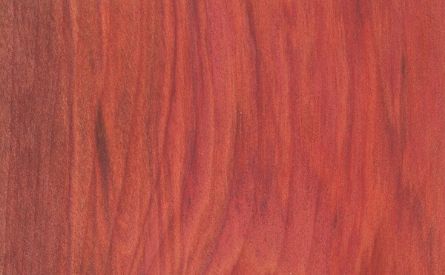CHAKTE KOK
Puntero / Simira salvadorensis

Local Names
Redheart, Saltemuche, Chacahuante, Palo de Rosa, Guayatil Colorado, Palo Colorado, Brasilete, Carmesí, Aguacatire, Paraguatá, Arareua, Arariba, Pau Brasil.
Distribution & Tree
Known as chakte kok in Peten and Mexico, puntero in Izabal and redheart commercially, the tree is found throughout continental tropical America from southern Mexico to Brazil and Paraguay. It is found in high jungle not prone to prolonged flooding and calcareous soils. It tends to occur in higher densities in disturbed areas. The tree reaches heights of 20 meters with a trunk diameter of 50 cm.
Wood Appearance
Red when freshly cut, the heartwood fades to a dark brown with a medium luster when dry and has a fine, uniform texture. Its grain is straight to irregular. When not exposed to regular sunlight or finished with UV inhibitors, the wood retains a bright cherry color.
Processing Properties
Working properties, including planing, machining and sanding, are good. Very good for sculpting, polishes and finishes well. It glues well but may be difficult to nail without pre-boring and may split during sawing. Due to a high percentage of sapwood, milling efficiencies are low, driving up the price of the heartwood.
Strength & Durability
Moderately heavy and laterally hard, it is rated as durable and the wood is fairly resistant to attack by fungi. Permeable and amenable to treatment.
Wood Uses
Turnery, railroad ties, boxes and crates, interior trim, millwork, veneers, tool handles, craft items, and light construction.
Ecological & Social Importance
The wood and bark yield a red dye used commercially and may have applications in histology. Leaves are sold in rolled bunches as roofing due to their durability of up to 10 years. Smaller leaves are utilized for hats, brooms, hand fans and baskets.
| Reference Species with Similar Density & Hardness | ||||
| Technical Characteristics | Chakte Kok | Black Maple | Northern Red Oak | |
| Density | kg/m3 | 640 | 640 | 700 |
| Janka Hardness | kgf | 549 | 535 | 553 |
| Bending Stiffness (Modulus of Elasticity) | GPa | 10.3 | 11.2 | 12.1 |
| Bending Strength (Modulus of Rupture) | MPa | 98.7 | 91.7 | 99.2 |
| Crushing Strength | MPa | 46.2 | 46.1 | 46.8 |
| Shrinkage, Radial | % | 2.8% | 4.8% | 4.0% |
| Shrinkage, Tangential | % | 8.2% | 9.3% | 8.6% |
| Shrinkage, Volumetric | % | 10.6% | 14.0% | 13.7% |
| T/R Ratio | 2.9 | 1.9 | 2.2 | |
| Values determined at 12% humidity - Provided for reference only | ||||
|---|---|---|---|---|
DENSITY
JANKA HARDNESS
BENDING STIFFNESS
BENDING STRENGTH
CRUSHING STRENGTH
SHRINKAGE
Values are for reference only and cannot be guaranteed. Wood is a natural material and physical and mechanical properties may vary depending on age, genetics, and other factors. We encourage customers to consult the references provided in the bibliography. For further explanations of wood’s key technical characteristics, an excellent resource is the Wood Database with articles on Density (average dried weight); Janka hardness; Elastic Modulus; Rupture Modulus; Crushing Strength; Radial, Tangential and Volumetric Shrinkage.






